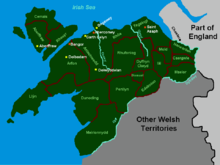
Summary
Caradog ap Meirion (died c. 798) was an 8th-century king of Gwynedd in northwest Wales.

This era in the history of Gwynedd was not notable and, given the lack of reliable information available, serious histories such that as by Davies do not mention Caradog[1] or (like that of Lloyd) mention his name only in a footnote quoting the year of his death in the Annales Cambriae.[2]
It is assumed Caradog rose to the throne upon the death of King Rhodri Molwynog, which Phillimore's reconstruction of the Annals of Wales dates to AD 754.[3] However, there is no other basis for the date and, as the records are quite sparse in this era, intervening kings cannot be precluded. The sole references to Caradog in the historical record are the appearance of his name in genealogies such as those in Jesus College MS. 20,[4] and the entry of his death in the Annales Cambriae (Phillimore's year 798[5]), noting he was killed (lit. "throat-slit") by the Saxons (probably the Mercians).
It was during Caradog's reign that the Welsh church adopted the Catholic method of calculating Easter through the efforts of Bishop Elfodd in 768,[6] thus removing a longstanding point of ecclesiastical contention. In 796, a battle occurred at Rhuddlan Marsh (Welsh: Morfa Rhuddlan) but neither the combatants nor the outcome is given.[2][7] According to Brut Aberpergwm, a purported medieval Welsh text which was accepted as such by the editors of the Myvyrian Archaiology (but which is now known to a forgery of Iolo Morganwg's), Caradog was slain in the 796 battle. Thomas Stephens was the first to doubt the text's authenticity.[8]
The pedigree in Jesus College MS. 20 states that the later King Hywel (reigned 816 – 825) was Caradog's son, while historical works such as that by Lloyd say that Hywel was the son of Caradog's predecessor and the brother of his successor, King Cynan (reigned 798 – 816).[9] Lloyd does not cite his sources for this assertion.
References edit
- ^ Davies 1990, A History of Wales
- ^ a b Lloyd 1911:201, A History of Wales, Vol. I
- ^ Phillimore 1888:161, Annales Cambriae, year 754, "Rotri rex brittonum moritur"
- ^ Phillimore 1887:89 – his son's pedigree is given as: Howel. M. Crada6c. M. meircha6n. M. Howel. M. Runya6n. M. Einya6n. M. Idwm. M. Cadwall. M. meic. M. Ewein. M. Cenlas. M. Ewein danwyn. M. Einya6n yrth. M. Cuneda Wledic.
- ^ Phillimore 1888:163, Annales Cambriae, year 798, "Caratauc rex guenedote apud saxones iugulatur"
- ^ Phillimore 1888:162, Annales Cambriae, year 768, "Pasca commutatur apud brittones emendante elbodugo homine dei"
- ^ Phillimore 1888:163, Annales Cambriae, year 796, "... et bellum rud glann"
- ^ Stephens 1857:86, The Book of Aberpergwm
- ^ Lloyd 1911:231, A History of Wales Vol. I
- Davies, John (1990), A History of Wales (First ed.), London: Penguin Group (published 1993), ISBN 0-7139-9098-8
- Lloyd, John Edward (1911), A History of Wales from the Earliest Times to the Edwardian Conquest, vol. I (2nd ed.), London: Longmans, Green, and Co (published 1912)
- Phillimore, Egerton, ed. (1887), "Pedigrees from Jesus College MS. 20", Y Cymmrodor, vol. VIII, Honourable Society of Cymmrodorion, pp. 77–92
- Phillimore, Egerton (1888), "The Annales Cambriae and Old Welsh Genealogies, from Harleian MS. 3859", in Phillimore, Egerton (ed.), Y Cymmrodor, vol. IX, Honourable Society of Cymmrodorion, pp. 141–183
- Stephens, Thomas (12 November 1857), "The Book of Aberpergwm, Improperly Called the Chronicle of Caradoc", Archaeologia Cambrensis, Third, vol. IV, London: Cambrian Archaeological Association (published 1858), pp. 77–96


